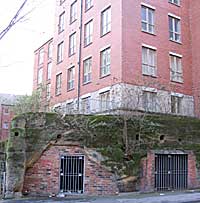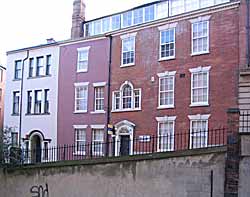< Previous | Contents | Next >

Bricked-up caves on Hollowstone (A Nicholson, 2004).
On the other side of Hollowstone are the remains of some caves, about which boys used to play until a fall of roof buried one of them alive. These caves, in addition to the hundreds of other caves which undermine Nottingham had an interesting effect upon the early trading history of the town. Nottingham was well situated for the supply of barley from the Vale of Belvoir, and the water of the town was found to be good for brewing. The beer that was brewed was matured in the equable temperature of these caves which vary but little from winter to summer. Nottingham ale early became famous, and considerable quantities were exported to other parts of the country, so that "Nottingham Nut Brown Ale" had more than a local celebrity. Of course, this was not such beer as we know nowadays, for hops were only introduced into England about 1525, just about the time of Henry VIII's divorce and the fall of Wolsey. But Nottingham continued to be famous for its beer until Messrs. Bass established their brewery at Burton sometime about 1770. The water at Burton was found to be richer in gypsum than was Nottingham water, and consequently Burton beer was more palatable than Nottingham beer, and so Burton gradually rose to be the metropolis of brewing, and Nottingham's trade declined.
On the southern side of Hollowstone are a number of entries into the cellarage of the houses upon Short Hill, for which records of trifling rents may be discovered by searching in the Borough Records. But the houses upon Short Hill above are very interesting. First of all, there is a XVII. century house at the eastern end which always looks to me as if it ought to have a very interesting story, but that story has eluded me, and beyond the fact that during the XVII . century it was used as a school, I can trace nothing of its past. In front of it was a public well which was filled up long ago.

Georgian houses on Short Hill (A Nicholson, 2004).
The houses facing Hollowstone (numbers 1 and 2) have plain and dignified 18th century doorways with good fanlights, and inside are excellent staircases. Of these wonderful staircases of Nottingham we shall hear more later. We know that in 1781 Mrs Suzanne Gregory died at her house on Short Hill. She was of some importance in her day and generation, and I have often wondered whether one of those houses may have been hers. The most dramatic resident upon Short Hill was Sir William Parsons, Baronet, whose son William was executed at Tyburn in 1751. This lad had a terrible history. He was born in 1717 and was educated at Eton. However, instead of attending to his studies he was detected in a robbery, and so his father sent him to sea instead of allowing him to proceed to one of the Universities. He spent three years as a midshipman at Jamaica, but eventually he deserted and returned to England, but was again shipped to sea, this time to Newfoundland. His conduct had been such that the Duchess of Northumberland had revoked her will and deprived him of a fortune which he would have inherited as her heir, and so in desperation he sank into a vicious life. After many adventures he was convicted as a forger of bills and sentenced to seven years transportation to Maryland. As a convict he was a terrible nuisance to the authorities, and eventually he escaped and returned to England. Thoroughly regardless of consequences he became a highwayman, and eventually was recognised as an escaped convict and condemned to death, and later was hanged as a malefactor upon the public gallows at Tyburn, in spite of all his father could do to save him.
Although a very old street, possibly a primeval trackway, Bellar Gate is not as old as Malin Hill and its attendant Short Stairs. As far back as 1315 it is spoken of as "Belwardgate," which name by 1650 had changed into "Bellgeter Gate," and finally to "Bellar Gate." Of course, bell-founding was an important industry in mediaeval Nottingham, and it is a great temptation to accept the late Mr. Stevenson's opinion that Bellar Gate was a settlement of bell-founders. But if we consider the history of Nottingham bell-founders, it is not very easy to accept Mr. Stevenson's theory. Dame Agnes Mellers, who founded the Nottingham Free School in 1513, is supposed to have lived in a house on the site now occupied by the Dispensary in Broad Street, and the bell foundry of her husband Richard Mellers to have been in a yard on the land now taken up by the General Post Office in Queen Street. Oldfield, as we have seen, was established in Foundry Yard, Narrow Marsh, in 1610, while Hedderley's work is so modern that it could not affect this name. In fact, he cast the bell, now used for St. James' Church, for a cotton mill in Broad Marsh in 1791, just before his departure to America.
For what it is worth, my opinion is that this name was originally meant for something like "Watchbell Street." It led to one of the town gates where watch would be kept, and where it is possible that an alarm bell hung, and the 1315 form of the name "Belward" is suspiciously like the well-known "Watchbell Street" in a similar position in the town of Rye in Sussex.
The road was lowered when Hollowstone was eased about 1812, which accounts for the fact that the burial ground is so much above the level of the road. That this difference in level has nothing to do with interments is proved by the fact that the first floor of the houses on the opposite side of the way are reached by several ascending steps. Between Dean Street and Hollowstone, Bellar Gate narrows a little and is contracted into a "straits," which were nicknamed "Gibraltar Straits" by our forefathers.
Close to Hollowstone and just behind "Horne's Castle" is Scotland Place, and out of Scotland Place leads White Cow Yard, which is all that remains of the yard of the "White Cow," an inn that formerly stood in Fisher Gate. This raised ground is the lower end of the cliff which forms Short Hill, and through which both Hollowstone and Bellar Gate have been cut.
White Cow Yard is entered from Scotland Place through a covered passage, at the north-west of which will be noticed a few old stones used as a footing for the brick wall. These are a part of the town wall of mediaeval Nottingham which fortune has left stranded in their original position. There were two sets of defences round Nottingham erected at an interval of two hundred years. After Edward the Elder, King Alfred's great son, captured Nottingham from the Danes in 918, he defended it. What his defence was I cannot say, probably a bank crowned by a stockade. It ran along the edge of the precipice overlooking Narrow Marsh, between Bridlesmith Gate and Fletcher Gate, between Goose Gate and Warser Gate, Hockley and Woolpack Lane, and so on to between Fisher Gate and White Cow Yard to its junction with the southern defence on the Marsh cliff. This enclosure remained till the Conquest, but after the establishment of Peveril's castle on the Castle rock about 1068 a fresh town grew up round about it and Nottingham spread a good deal outside its defences. During the dreadful reign of King Stephen, Nottingham Castle was held for the King, and in 1140 it was unsuccessfully attacked by Queen Matilda's forces, under the Earl of Gloucester. Although unsuccessful in his assault upon the Castle, Gloucester captured the town and did so much damage that when Henry II. ascended the throne in 1154 he was fain not only to assist the citizens in rebuilding their houses but to grant them aids towards fortifying themselves against a repetition of the disaster. Of this fortification which was part wall, part bank and part ditch, many fragments have come down to us. Commencing at Postern Street it ran down the east side of Park Row, just behind the modern houses. At Chapel Bar was a gateway, and the fortification then passed along the middle of Parliament Street to Clumber Street, where was situated another gateway. Continuing along Parliament Street and St. John's Street it worked parallel with Coalpit Lane and Count Street until it eventually joined Edward the Elder's defences at Hollowstone. Proceeding along the Marsh precipice it takes in Weekday Cross and runs south of Low Pavement and diagonally across Lister Gate to Walnut Tree Lane and so to rejoin the Castle fortifications. This defence was repaired in later times, and fragments are continually being discovered when excavations are being made.
The burial ground, with its solitary tomb, is now used as a playground, and is one of three burial grounds, in addition to the churchyard and the Cholera Burial Ground in Bath Street, associated with St. Mary's Church. Terrible mental distress was caused in the early part of last century by the depredations of body-snatchers in these cemeteries. Medicine and surgery were making great strides, but the sciences were handicapped by the scarcity of bodies for dissection, for the human body after death was looked upon as almost sacro-sanct. Some attempt to meet this want was made by handing over bodies of executed criminals to the doctors, but the demand was greater than the supply, and there rose up a body of men who pursued the ghoulish trade of stealing newly interred bodies and selling them to doctors. Many devices were adopted to frustrate them. Watchers were appointed to guard burial grounds, graves were enclosed within iron palisades, but the most efficient was the brick vault and combrous table-tomb that could not be tampered with without noise. As far as Nottingham was concerned the suspicions of Pickford's agent were aroused in 1827 as to the contents of a hamper brought to his warehouse. This led to an enquiry and to the discovery that a man called Smith living in Maiden Lane had, with the help of two assistants, stolen thirty bodies from St. Mary's cemeteries.
